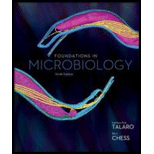
Concept explainers
What do you suppose the world would be like if there were cures for all infectious diseases and a means to destroy all microbes? What characteristics of microbes would prevent this from happening?
To analyze:
- The scenario if cures for all infectious diseases were found and all microbes could be destroyed.
- The characteristics of microbes that would prevent such a situation from happening.
Introduction:
Infectious diseases caused by micro-organisms are a cause of widespread mortality and morbidity. While some infectious diseases have been eradicated because of vaccination and antibiotics, many others still continue to prevail. Currently, almost 2000 different pathogens infect humans and cause diseases, and more than 10 billion infections are reported across the globe, each year. This is because antibiotics are ineffective against many micro-organisms. Such micro-organisms have devised strategies to counteract the effect of antibiotics, and are causing infections in humans.
Explanation of Solution
If we imagine a scenario where cures for all infectious diseases have been found, there would be a significant increase in the lifespan of humans. Consequently, humans will over-populate the earth and cause a tremendous pressure on natural resources. If all microbes would be destroyed, there would be drastic changes in ecosystems and natural processes. The oxygen content in the atmosphere would reduce to critical levels, because of absence of photosynthesizing bacteria. Decomposition and mineral recycling will cease, thereby making elements inaccessible to humans and plants. The levels of greenhouse gases like carbon dioxide and methane would go down, and this would make the temperature of the earth fall down severely. All these changes would in turn make earth inhabitable for humans, and threaten their existence.
The immense resistance of micro-organisms gives them the ability to thrive under extremes of temperature, salt content and pH, and in toxic wastelands, radioactive areas and even in volcanoes. They are able to adapt quickly and become drug-resistant, thereby making it difficult for us to destroy them.
Want to see more full solutions like this?
Chapter 1 Solutions
Foundations in Microbiology
- What does it mean to say microbes are ubiquitous?arrow_forwardSince the seventies, scientists have been manipulating microorganisms to improve humans’ well-being. What are examples of how scientists use microorganisms to improve human life quality.arrow_forwardKoch's Postulate proved that: normal flora are necessary for life some diseases are caused by microbes yeasts produce alcohol from sugar viruses are not cellsarrow_forward
- If someone is contaminated with a bacterium from the environment, are they guaranteed to develop a disease? O Yes, contamination precedes disease and only one microbe is needed for disease development. Yes, a contamination implies that the patient will develop an illness. O No, contamination is just the mere presence of microbes in or on the body. O No, only non-living surfaces may be contaminated.arrow_forwardIf all prokaryotes were eliminated from the planeta) animals would thrive because there would be no disease.b) archaea would thrive because there would be no competition for nutrients.c) all animals would die.d) animals and archaea would thrive.arrow_forwardMicro-organisms can be found in almost any environment and on many objects. Name two objects or products you use that likely contain micro-organisms. Why do you think they do?arrow_forward
- How do scientists use microorganisms to improve human life quality?arrow_forwardWhat microbial structures are the most resilient forms of life? Bacterial endospores Enveloped viruses Fungal spores Gram-positive bacteriaarrow_forwardtwo ways bacteria are harmful and two ways they are helpful to humans?arrow_forward
- Describe the three major domains of life: Archaea, Bacteria, and Eukarya. Explain what the three domains have in common and how they differ. Define viruses, and explain how they relate to living cells. Explain how microbial diseases have changed human history. Explain the tenets of Cell Theory Describe how microscopy led to the Germ Theory of infectious disease Define the germ theory of disease. Explain how Koch's postulates can show that a specific kind of microbe causes a disease. Explain the problems in interpreting Koch's postulates in practice.arrow_forwardIn his experiments using bacteria and mice, Griffith discovered that: heat-killed bacteria can kill mice non-pathogenic bacteria can never be made to cause disease some substance from pathogenic cells could be transferred to non-pathogenic cells, making them pathogenic the capsule from pathogenic bacteria could transform non-pathogenic bacteria E O O O Oarrow_forwardWhy do you think there are limited scientists like microbiologists that focuses in studying organisms such as archaea?arrow_forward
 Human Anatomy & Physiology (11th Edition)BiologyISBN:9780134580999Author:Elaine N. Marieb, Katja N. HoehnPublisher:PEARSON
Human Anatomy & Physiology (11th Edition)BiologyISBN:9780134580999Author:Elaine N. Marieb, Katja N. HoehnPublisher:PEARSON Biology 2eBiologyISBN:9781947172517Author:Matthew Douglas, Jung Choi, Mary Ann ClarkPublisher:OpenStax
Biology 2eBiologyISBN:9781947172517Author:Matthew Douglas, Jung Choi, Mary Ann ClarkPublisher:OpenStax Anatomy & PhysiologyBiologyISBN:9781259398629Author:McKinley, Michael P., O'loughlin, Valerie Dean, Bidle, Theresa StouterPublisher:Mcgraw Hill Education,
Anatomy & PhysiologyBiologyISBN:9781259398629Author:McKinley, Michael P., O'loughlin, Valerie Dean, Bidle, Theresa StouterPublisher:Mcgraw Hill Education, Molecular Biology of the Cell (Sixth Edition)BiologyISBN:9780815344322Author:Bruce Alberts, Alexander D. Johnson, Julian Lewis, David Morgan, Martin Raff, Keith Roberts, Peter WalterPublisher:W. W. Norton & Company
Molecular Biology of the Cell (Sixth Edition)BiologyISBN:9780815344322Author:Bruce Alberts, Alexander D. Johnson, Julian Lewis, David Morgan, Martin Raff, Keith Roberts, Peter WalterPublisher:W. W. Norton & Company Laboratory Manual For Human Anatomy & PhysiologyBiologyISBN:9781260159363Author:Martin, Terry R., Prentice-craver, CynthiaPublisher:McGraw-Hill Publishing Co.
Laboratory Manual For Human Anatomy & PhysiologyBiologyISBN:9781260159363Author:Martin, Terry R., Prentice-craver, CynthiaPublisher:McGraw-Hill Publishing Co. Inquiry Into Life (16th Edition)BiologyISBN:9781260231700Author:Sylvia S. Mader, Michael WindelspechtPublisher:McGraw Hill Education
Inquiry Into Life (16th Edition)BiologyISBN:9781260231700Author:Sylvia S. Mader, Michael WindelspechtPublisher:McGraw Hill Education





